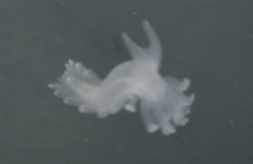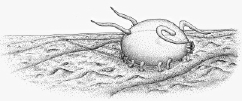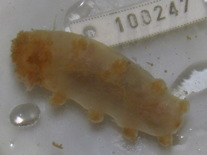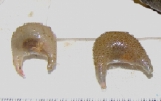|
|
Echinoderms ("spiny skin") are one of the few
animal phyla that are totally marine. They typically have a unique
five-fold symmetry and a unique locomotory system consisting of
hundreds of tube feet. Most groups are quite common in shallow
waters, but for unknown reasons, they are extremely successful in
the deep. Sea cucumbers (including sea pig types--pictures
below, and diagrammed to the left) (Holothuroidea) are often
the most common macroscopic animal in deep dredges. Sea pigs
have been found at the greatest depths, about 11,000m in the Mariana
Trench! -- Click
Here for fun website on SEA PIGS. Most sea pigs plow
along like worms and engulf the deep-sea mud, digesting organics and
bacteria. However, there are some sea pig species that can swim
above the bottom; see picture to right-->
Seastars or Starfish (Asteroidea) creep along with their tube feet
and eat live prey and dead remains. Brittle and basket stars
(Ophiuroidea) use their flexible arms rather than tube feet.
Brittles move through the mud, scooping up organic remains; some
brittles and the basket stars catch floating organic particles. Sea
urchins (Echinoidea) are ovoid and covered with spines; they
probably eat organic remains. They are usually rigid, but some of
the abyssal ones are curiously soft and flexible. Sea lilies
(Crinoidea) are like inverted starfish, with their arms up in the
current to catch organic particles. |

A swimming sea pig that we filmed at 7000m in the Kermadec Trench,
shown in Blue Planet II Episode 2 (erroneously
called a sea slug). |





















